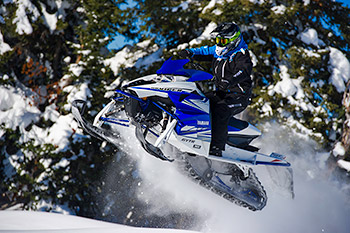We’ve discovered a few tricks getting our Yamaha Viper X-TX riding better and wanted to pass the info on to you while the snow is down.
First, we’ve been really impressed with how well the Arctic Cat Sno-Pros are riding this year. At the same time we were not that pleased with the ride results from our Viper X-TX SE.
To be fair, the X-TX is not targeted as a pure trail sled but rather is more at home riding powder. However, you usually still have to ride trails to get to your fave powder location and the ride can jar all your tooth fillings loose getting there.
Back to Arctic Cat: This year Cat’s engineers changed the damping rates and air pressure settings on a number of their 129, 137 and 141-inch sleds to get them to ride more smoothly. We had assumed the same settings prevailed with Yamaha but they do not. We got out our air pressure pump (the one supplied in the tool-kit) and found that Cat’s air shock settings for the front were 72 to 75-psi, depending on the model.
We then checked the Viper and found the settings were 90 to 95-psi. The front end of the Viper was sitting way high and it was hard to get any static movement in the front shocks at all. When we dropped the air pressure down to 75-psi on the front shocks, the Viper sat a bit lower and there was nice movement in the shocks over washboard and chatter bumps. So far we’ve experienced no bottoming issues.
We didn’t change anything with the center coilover gas shock but checked the air pressure in the rear shock and found it to be 137-lbs. of its maximum allowable 150. We immediately dropped the pressure to 100-psi and got some nice movement in the skidframe.
The sled’s ride was vastly improved and so far we can’t see that it’s negatively affected the deep-snow performance of the X-TX at all. One thing’s for sure: The sled is way more compliant on trails.
We’d recommend these changes for anyone whose body weight goes up to about 200-lbs and if you find you need more air pressure in the rear we’d only bump it up in 5-lb increments to a max of about 115-psi with no rider, sled on the ground. If you’re bottoming out at that pressure level, you need to go on a diet!
BTW: Using this pump is a breeze. Honestly, it doesn’t take any longer than checking the tire pressure on your pick-up and the pump is very accurate. The hardest part is knowing where to begin with pressures and we’ve just supplied that for you.
Good luck.




